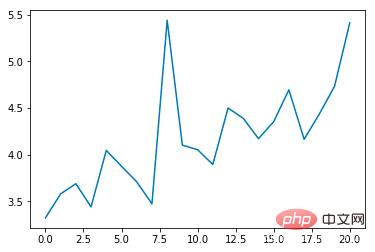學習Python實現自動駕駛系統

安裝環境
gym是用來開發和比較強化學習演算法的工具包,在python中安裝gym函式庫和其中子場景都較為簡單。
安裝gym:
pip install gym
安裝自動駕駛模組,這裡使用Edouard Leurent 發佈在github 上的套件highway-env:
pip install --user git+https://github.com/eleurent/highway-env
其中包含6個場景:
- 高速公路—「highway-v0」
- 匯入—「merge-v0」
- 環島—「roundabout-v0」
- # 停車——「parking-v0」
- 十字路口——「intersection-v0」
- 賽車道——「racetrack-v0」
#https://www.php.cn/link/c0fda89ebd645bd7cea60fcbb5960309
#設定環境安裝好後即可在程式碼中進行實驗(以高速公路場景為例):import gym
import highway_env
%matplotlib inline
env = gym.make('highway-v0')
env.reset()
for _ in range(3):
action = env.action_type.actions_indexes["IDLE"]
obs, reward, done, info = env.step(action)
env.render()

config =
{
"observation":
{
"type": "Kinematics",
#选取5辆车进行观察(包括ego vehicle)
"vehicles_count": 5,
#共7个特征
"features": ["presence", "x", "y", "vx", "vy", "cos_h", "sin_h"],
"features_range":
{
"x": [-100, 100],
"y": [-100, 100],
"vx": [-20, 20],
"vy": [-20, 20]
},
"absolute": False,
"order": "sorted"
},
"simulation_frequency": 8,# [Hz]
"policy_frequency": 2,# [Hz]
}
ACTIONS_ALL = {
0: 'LANE_LEFT',
1: 'IDLE',
2: 'LANE_RIGHT',
3: 'FASTER',
4: 'SLOWER'
}

import torch
import torch.nn as nn
from torch.autograd import Variable
import torch.nn.functional as F
import torch.optim as optim
import torchvision.transforms as T
from torch import FloatTensor, LongTensor, ByteTensor
from collections import namedtuple
import random
Tensor = FloatTensor
EPSILON = 0# epsilon used for epsilon greedy approach
GAMMA = 0.9
TARGET_NETWORK_REPLACE_FREQ = 40 # How frequently target netowrk updates
MEMORY_CAPACITY = 100
BATCH_SIZE = 80
LR = 0.01 # learning rate
class DQNNet(nn.Module):
def __init__(self):
super(DQNNet,self).__init__()
self.linear1 = nn.Linear(35,35)
self.linear2 = nn.Linear(35,5)
def forward(self,s):
s=torch.FloatTensor(s)
s = s.view(s.size(0),1,35)
s = self.linear1(s)
s = self.linear2(s)
return s
class DQN(object):
def __init__(self):
self.net,self.target_net = DQNNet(),DQNNet()
self.learn_step_counter = 0
self.memory = []
self.position = 0
self.capacity = MEMORY_CAPACITY
self.optimizer = torch.optim.Adam(self.net.parameters(), lr=LR)
self.loss_func = nn.MSELoss()
def choose_action(self,s,e):
x=np.expand_dims(s, axis=0)
if np.random.uniform() < 1-e:
actions_value = self.net.forward(x)
action = torch.max(actions_value,-1)[1].data.numpy()
action = action.max()
else:
action = np.random.randint(0, 5)
return action
def push_memory(self, s, a, r, s_):
if len(self.memory) < self.capacity:
self.memory.append(None)
self.memory[self.position] = Transition(torch.unsqueeze(torch.FloatTensor(s), 0),torch.unsqueeze(torch.FloatTensor(s_), 0),
torch.from_numpy(np.array([a])),torch.from_numpy(np.array([r],dtype='float32')))#
self.position = (self.position + 1) % self.capacity
def get_sample(self,batch_size):
sample = random.sample(self.memory,batch_size)
return sample
def learn(self):
if self.learn_step_counter % TARGET_NETWORK_REPLACE_FREQ == 0:
self.target_net.load_state_dict(self.net.state_dict())
self.learn_step_counter += 1
transitions = self.get_sample(BATCH_SIZE)
batch = Transition(*zip(*transitions))
b_s = Variable(torch.cat(batch.state))
b_s_ = Variable(torch.cat(batch.next_state))
b_a = Variable(torch.cat(batch.action))
b_r = Variable(torch.cat(batch.reward))
q_eval = self.net.forward(b_s).squeeze(1).gather(1,b_a.unsqueeze(1).to(torch.int64))
q_next = self.target_net.forward(b_s_).detach() #
q_target = b_r + GAMMA * q_next.squeeze(1).max(1)[0].view(BATCH_SIZE, 1).t()
loss = self.loss_func(q_eval, q_target.t())
self.optimizer.zero_grad() # reset the gradient to zero
loss.backward()
self.optimizer.step() # execute back propagation for one step
return loss
Transition = namedtuple('Transition',('state', 'next_state','action', 'reward'))
import gym
import highway_env
from matplotlib import pyplot as plt
import numpy as np
import time
config =
{
"observation":
{
"type": "Kinematics",
"vehicles_count": 5,
"features": ["presence", "x", "y", "vx", "vy", "cos_h", "sin_h"],
"features_range":
{
"x": [-100, 100],
"y": [-100, 100],
"vx": [-20, 20],
"vy": [-20, 20]
},
"absolute": False,
"order": "sorted"
},
"simulation_frequency": 8,# [Hz]
"policy_frequency": 2,# [Hz]
}
env = gym.make("highway-v0")
env.configure(config)
dqn=DQN()
count=0
reward=[]
avg_reward=0
all_reward=[]
time_=[]
all_time=[]
collision_his=[]
all_collision=[]
while True:
done = False
start_time=time.time()
s = env.reset()
while not done:
e = np.exp(-count/300)#随机选择action的概率,随着训练次数增多逐渐降低
a = dqn.choose_action(s,e)
s_, r, done, info = env.step(a)
env.render()
dqn.push_memory(s, a, r, s_)
if ((dqn.position !=0)&(dqn.position % 99==0)):
loss_=dqn.learn()
count+=1
print('trained times:',count)
if (count%40==0):
avg_reward=np.mean(reward)
avg_time=np.mean(time_)
collision_rate=np.mean(collision_his)
all_reward.append(avg_reward)
all_time.append(avg_time)
all_collision.append(collision_rate)
plt.plot(all_reward)
plt.show()
plt.plot(all_time)
plt.show()
plt.plot(all_collision)
plt.show()
reward=[]
time_=[]
collision_his=[]
s = s_
reward.append(r)
end_time=time.time()
episode_time=end_time-start_time
time_.append(episode_time)
is_collision=1 if info['crashed']==True else 0
collision_his.append(is_collision)



以上是學習Python實現自動駕駛系統的詳細內容。更多資訊請關注PHP中文網其他相關文章!

熱AI工具

Undresser.AI Undress
人工智慧驅動的應用程序,用於創建逼真的裸體照片

AI Clothes Remover
用於從照片中去除衣服的線上人工智慧工具。

Undress AI Tool
免費脫衣圖片

Clothoff.io
AI脫衣器

Video Face Swap
使用我們完全免費的人工智慧換臉工具,輕鬆在任何影片中換臉!

熱門文章

熱工具

記事本++7.3.1
好用且免費的程式碼編輯器

SublimeText3漢化版
中文版,非常好用

禪工作室 13.0.1
強大的PHP整合開發環境

Dreamweaver CS6
視覺化網頁開發工具

SublimeText3 Mac版
神級程式碼編輯軟體(SublimeText3)
 幣圈行情實時數據免費平台推薦前十名發布
Apr 22, 2025 am 08:12 AM
幣圈行情實時數據免費平台推薦前十名發布
Apr 22, 2025 am 08:12 AM
適合新手的加密貨幣數據平台有CoinMarketCap和非小號。 1. CoinMarketCap提供全球加密貨幣實時價格、市值、交易量排名,適合新手與基礎分析需求。 2. 非小號提供中文友好界面,適合中文用戶快速篩選低風險潛力項目。
 okx在線 okx交易所官網在線
Apr 22, 2025 am 06:45 AM
okx在線 okx交易所官網在線
Apr 22, 2025 am 06:45 AM
OKX 交易所的詳細介紹如下:1) 發展歷程:2017 年創辦,2022 年更名為 OKX;2) 總部位於塞舌爾;3) 業務範圍涵蓋多種交易產品,支持 350 多種加密貨幣;4) 用戶遍布 200 餘個國家,千萬級用戶量;5) 採用多重安全措施保障用戶資產;6) 交易費用基於做市商模式,費率隨交易量增加而降低;7) 曾獲多項榮譽,如“年度加密貨幣交易所”等。
 各大虛擬貨幣交易平台的特色服務一覽
Apr 22, 2025 am 08:09 AM
各大虛擬貨幣交易平台的特色服務一覽
Apr 22, 2025 am 08:09 AM
機構投資者應選擇Coinbase Pro和Genesis Trading等合規平台,關注冷存儲比例與審計透明度;散戶投資者應選擇幣安和火幣等大平台,注重用戶體驗與安全;合規敏感地區的用戶可通過Circle Trade和Huobi Global進行法幣交易,中國大陸用戶需通過合規場外渠道。
 大宗交易的虛擬貨幣交易平台排行榜top10最新發布
Apr 22, 2025 am 08:18 AM
大宗交易的虛擬貨幣交易平台排行榜top10最新發布
Apr 22, 2025 am 08:18 AM
選擇大宗交易平台時應考慮以下因素:1. 流動性:優先選擇日均交易量超50億美元的平台。 2. 合規性:查看平台是否持有美國FinCEN、歐盟MiCA等牌照。 3. 安全性:冷錢包存儲比例和保險機制是關鍵指標。 4. 服務能力:是否提供專屬客戶經理和定制化交易工具。
 支持多種幣種的虛擬貨幣交易平台推薦前十名一覽
Apr 22, 2025 am 08:15 AM
支持多種幣種的虛擬貨幣交易平台推薦前十名一覽
Apr 22, 2025 am 08:15 AM
優先選擇合規平台如OKX和Coinbase,啟用多重驗證,資產自託管可減少依賴:1. 選擇有監管牌照的交易所;2. 開啟2FA和提幣白名單;3. 使用硬件錢包或支持自託管的平台。
 數字貨幣交易app容易上手的推薦top10(025年最新排名)
Apr 22, 2025 am 07:45 AM
數字貨幣交易app容易上手的推薦top10(025年最新排名)
Apr 22, 2025 am 07:45 AM
gate.io(全球版)核心優勢是界面極簡,支持中文,法幣交易流程直觀;幣安(簡版)核心優勢是全球交易量第一,簡版模式僅保留現貨交易;OKX(香港版)核心優勢是界面簡潔,支持粵語/普通話,衍生品交易門檻低;火幣全球站(香港版)核心優勢是老牌交易所,推出元宇宙交易終端;KuCoin(中文社區版)核心優勢是支持800 幣種,界面採用微信式交互;Kraken(香港版)核心優勢是美國老牌交易所,持有香港SVF牌照,界面簡潔;HashKey Exchange(香港持牌)核心優勢是香港知名持牌交易所,支持法
 幣圈十大行情網站的使用技巧與推薦2025
Apr 22, 2025 am 08:03 AM
幣圈十大行情網站的使用技巧與推薦2025
Apr 22, 2025 am 08:03 AM
國內用戶適配方案包括合規渠道和本地化工具。 1. 合規渠道:通過OTC平台如Circle Trade進行法幣兌換,境內需通過香港或海外平台。 2. 本地化工具:使用幣圈網獲取中文資訊,火幣全球站提供元宇宙交易終端。
 數字貨幣交易所App前十名蘋果版下載入口匯總
Apr 22, 2025 am 09:27 AM
數字貨幣交易所App前十名蘋果版下載入口匯總
Apr 22, 2025 am 09:27 AM
提供各種複雜的交易工具和市場分析。覆蓋 100 多個國家,日均衍生品交易量超 300 億美元,支持 300 多個交易對與 200 倍槓桿,技術實力強大,擁有龐大的全球用戶基礎,提供專業的交易平台、安全存儲解決方案以及豐富的交易對。






